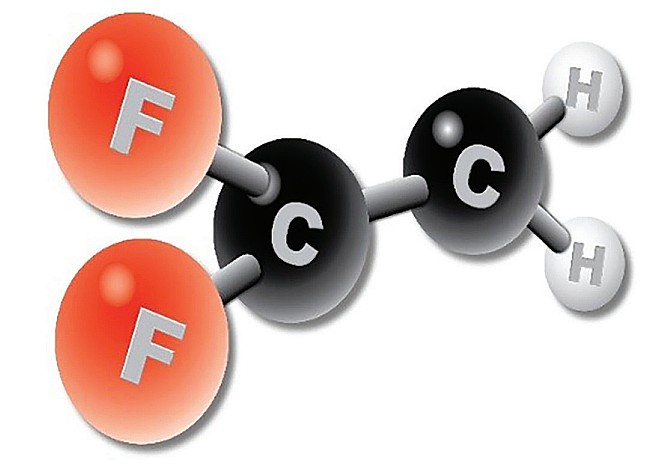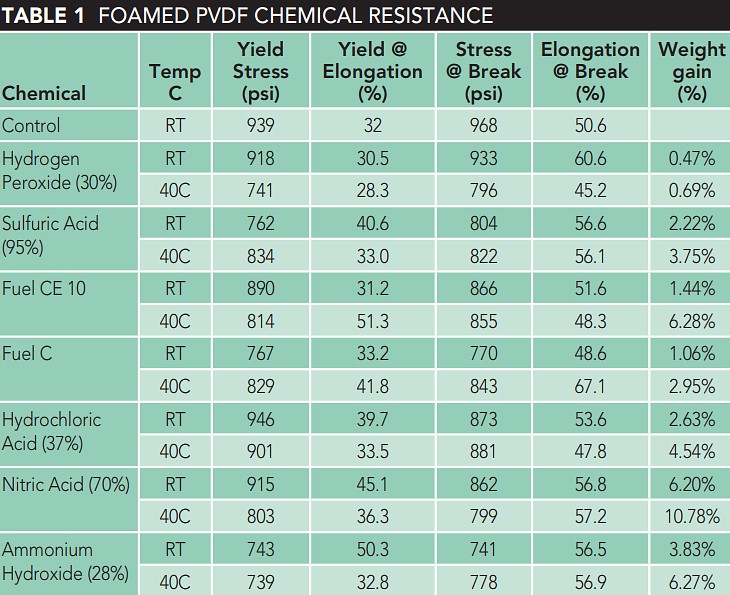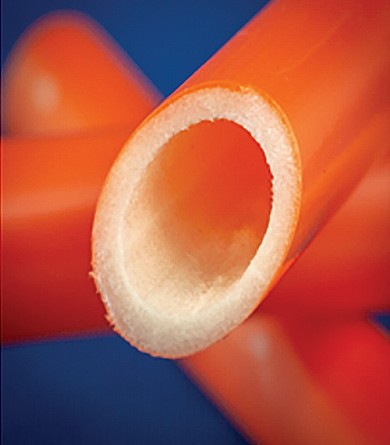Polyvinylidene fluoride (PVDF) is naturally mechanically strong and resistant to many harsh chemicals, making it an ideal candidate to protect chemical processing equipment from corrosion. New advancements in PVDF technology allow it to be extruded with a foam concentrate. This creates new, lighter-weight PVDF materials that can be used in a variety of chemical applications–all at a more cost-effective rate.
As the global chemical processing industry continues to expand, there is a constant demand for materials that can hold up to challenging chemical and mechanical environments.
Chemical corrosion can occur in many areas in the industry, and it can pose a challenge for engineers even when the chemical is a consumer good. Corrosion can appear in large chemical mixing tanks in the form of pitting, or in stainless steel pipes carrying a concentrated acid for an extended period of time.
To prevent this, engineers can turn to high-performance plastics to protect systems from corroding. Many polymeric materials are favored in the chemical industry due to their lightweight nature and ease of fabrication.
One of the materials often considered for applications such as these is polyvinylidene fluoride (PVDF), a high-performance polymer that falls into the fluoropolymer family, a category of polymers that contain fluorine in their backbone. Fluoropolymers are well-known for their outstanding chemical resistance, high-temperature rating, and high purity. PVDF is a partially fluorinated polymer, and the monomer that forms its chemical makeup is shown in Figure 1.

The inclusion of hydrogen atoms in the polymer chain makes PVDF more crystalline, leading to higher permeation resistance and mechanical stability compared to other fluoropolymers. PVDF is melt processable and has a much larger processing window than any other fluoropolymer and can be processed on standard equipment used for polyolefins. This opens it up to a variety of applications.
While frequently used in industry as a homopolymer, PVDF can also be copolymerized with a different monomer, like hexafluoropropylene (HFP). This increases the material’s flexibility and ductility, all while preserving its chemical resistance, processability, and UV resistance.
Certain grades of PVDF-HFP copolymer also maintain the same thermal stability of a homopolymer. The amount of HFP in the material can vary, leading to a wide range of flexibility depending on the application.
PVDF can be used in a myriad of industrial applications, and it is commonly found in environments where high-abrasion resistance, mechanical strength at elevated temperatures, UV stability, and corrosion resistance are all desired. PVDF can be extruded into pipe and used in piping systems that are lightweight and do not rust, unlike metals.1
Stock shapes such as rods and sheets can also be extruded with PVDF, and those stock shapes can be machined into detailed parts so that the end user does not have to invest in injection molding equipment. Extruded PVDF sheets can also be fabricated into corrosion-resistant tank liners, which can be placed in or bonded to the tank.
PVDF copolymers are commonly used as flexible tubing, and its low-permeation barrier properties are also valued in the oil and gas industry.2 PVDF copolymer is also commonly used in the wire and cable market, typically as a protective outside jacket for its smoke and flame resistance.
In addition to these performance characteristics, certain properties of PVDF can be optimized for specific applications. Design engineers and end users are constantly looking for materials that are lighter-weight, more flexible, and ultimately can be priced more cost-effectively.
Recent developments in PVDF technology have produced a foam concentrate that can address all these concerns on the engineer’s wish list. This foam concentrate can be added to certain grades of PVDF resin during the extrusion process to achieve the desired density reduction in the finished part. The result is a closed cell foam, meaning that there are no visible voids in the foamed part–all voids are contained within a thin exterior layer. Figure 2 (top image) shows a cross-section of a closed-cell PVDF foam.

The closed-cell structure is important, as it allows the PVDF to keep the aforementioned properties. A closed-cell foam PVDF part will maintain its chemical resistance, thermal stability, smoke and flame characteristics, and UV weatherability. Table 1 shows the sustained chemical resistance with foamed PVDF when exposed to a variety of chemicals.
This new foam concentrate, when dispersed evenly, can achieve up to 85% density reduction, bringing the density as low as 0.27 g/cm3. This is a remarkable drop in density and lends a few properties to foamed PVDF that were once unattainable to virgin PVDF resin. This reduction also increases the flexibility and decreases the thermal conductivity of the material.
These new properties open the material to a variety of new applications, and engineers can now take advantage of these desired properties.
Applications already exist in chemical tanks, where foamed PVDF cylinders can be found at the surface of chemical storage tanks to reduce evaporation while protecting the tanks from corroding or pitting. A combination of chemical resistance, UV and weathering resistance, and the ability to float make this material the ideal choice for this application.
Wire and cable jacketing and micro-ducts are also an existing application for foamed PVDF. Because the material keeps its smoke and flame properties, engineers can now make cables lightweight and more cost-effective. This allows PVDF to be specified in constructions that would typically call out a more commodity material.3

Figure 3 shows a picture of a foamed PVDF microduct. This is a coextrusion with a “skin” of unfoamed PVDF on the interior and exterior to provide a smooth layer for ease of installation. The foamed jacketing also allows for easier cable strippability.
Double containment piping is an application that already exists for PVDF in situations where engineers need peace of mind when designing piping systems for highly corrosive chemicals. In these systems, the inner pipe handling the chemical will be the most inert material, designed to withstand chemical service. The outermost pipe is traditionally made from an inexpensive material with less chemical resistance.
If the inner pipe has a failure, that outer pipe then becomes a containment pipe, designed to keep the chemical contained, until the piping system can be replaced. As PVDF is typically used on the inner layer for a pipe, engineers can keep costs the same and increase the chemical resistance of the overall system by using foamed PVDF as the outer layer.
Ducting and air-handling systems for corrosive fluids can now be fabricated from a rolled sheet of foamed PVDF, at a cost like many of the most common materials on the market. The foamed PVDF brings lighter weight, increased chemical resistance, and greater smoke- and flame-resistant properties than traditional materials of construction.
Chemical tank linings can be manufactured using extruded foam sheets. Since the foamed PVDF keeps its thermal stability and chemical resistance, a tank made with foamed PVDF would offer a lower-cost and lighter-weight option than unfoamed PVDF, with similar performance. Common tank applications include acid storage, chemical plating lines, and over-the-road trailer linings.4
PVDF is commonly specified as a material of choice for demanding applications that require high thermal stability, chemical resistance, smoke and flame resistance, and weatherability. By foaming PVDF resin and reducing its density, design engineers can now look to optimize the characteristics of PVDF for their applications or begin to look at new applications altogether.
Editor’s note: This article first appeared in the December 2023 print issue of Materials Performance (MP) Magazine. Reprinted with permission.
References
1 A. Peters, S. Mutton, “Case Study: PVDF Pipeline for Fructose Transportation,” Processing 34, 7 (2021): pp. 30–33.
2 L. Bryant, T. Ngawing, “The Uses of Polyvinylidene Fluoride based resins in Chemical Handling Systems,” 2nd NDT & Corrosion Management Asia Conference (Singapore: Joint NDTS Singapore/PetroMin/Hydrocarbon Asia, 2006).
3 J. Henry, R. Partridge, “Low Smoke & Limited Combustible Cables Made With PVDF,” Wire & Cable Technology International (2005): pp. 2–4.
4 T. Goad, G. Dennis, A. Palovcak, “Maximizing the Service Life of Process Tanks,” Products Finishing 83, 12 (2019): pp. 18–22.